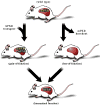Use of transgenic mice in UDP-glucuronosyltransferase (UGT) studies
- PMID: 20070245
- PMCID: PMC2807998
- DOI: 10.3109/03602530903208983
Use of transgenic mice in UDP-glucuronosyltransferase (UGT) studies
Abstract
Transgenic mouse models are useful to understand the function and regulation of drug-metabolizing enzymes in vivo. This article is intended to describe the general strategies and to discuss specific examples on how to use transgenic, gene knockout, and humanized mice to study the function as well as genetic and pharmacological regulation of UDP-glucuronosyltransferases (UGTs). The physiological and pharmacological implications of transcription factor-mediated UGT regulation will also be discussed. The UGT-regulating transcription factors to be discussed in this article include nuclear hormone receptors (NRs), aryl hydrocarbon receptor (AhR), and nuclear factor erythroid 2-related factor 2 (Nrf2).
Figures





Similar articles
-
Induction of mouse UDP-glucuronosyltransferase mRNA expression in liver and intestine by activators of aryl-hydrocarbon receptor, constitutive androstane receptor, pregnane X receptor, peroxisome proliferator-activated receptor alpha, and nuclear factor erythroid 2-related factor 2.Drug Metab Dispos. 2009 Apr;37(4):847-56. doi: 10.1124/dmd.108.024190. Epub 2009 Jan 14. Drug Metab Dispos. 2009. PMID: 19144771 Free PMC article.
-
Coordinated regulation of hepatic phase I and II drug-metabolizing genes and transporters using AhR-, CAR-, PXR-, PPARα-, and Nrf2-null mice.Drug Metab Dispos. 2012 Jul;40(7):1366-79. doi: 10.1124/dmd.112.045112. Epub 2012 Apr 11. Drug Metab Dispos. 2012. PMID: 22496397 Free PMC article.
-
UDP-glucuronosyltransferases (UGTs): from purification of Ah-receptor-inducible UGT1A6 to coordinate regulation of subsets of CYPs, UGTs, and ABC transporters by nuclear receptors.Drug Metab Rev. 2010 Feb;42(1):6-13. doi: 10.3109/03602530903205492. Drug Metab Rev. 2010. PMID: 19831498 Review.
-
Octachlorostyrene induces cytochrome P450, UDP-glucuronosyltransferase, and sulfotransferase via the aryl hydrocarbon receptor and constitutive androstane receptor.Toxicol Sci. 2009 Sep;111(1):19-26. doi: 10.1093/toxsci/kfp130. Epub 2009 Jun 12. Toxicol Sci. 2009. PMID: 19525444
-
Phytochemical regulation of UDP-glucuronosyltransferases: implications for cancer prevention.Nutr Cancer. 2007;59(2):121-41. doi: 10.1080/01635580701458178. Nutr Cancer. 2007. PMID: 18001207 Review.
Cited by
-
UDP-glucuronosyltransferase expression in mouse liver is increased in obesity- and fasting-induced steatosis.Drug Metab Dispos. 2012 Feb;40(2):259-66. doi: 10.1124/dmd.111.039925. Epub 2011 Oct 26. Drug Metab Dispos. 2012. PMID: 22031624 Free PMC article.
-
Drug-metabolizing enzyme, transporter, and nuclear receptor genetically modified mouse models.Drug Metab Rev. 2011 Feb;43(1):27-40. doi: 10.3109/03602532.2010.512294. Epub 2010 Sep 21. Drug Metab Rev. 2011. PMID: 20854191 Free PMC article. Review.
-
Hepatic expression of transcription factors affecting developmental regulation of UGT1A1 in the Han Chinese population.Eur J Clin Pharmacol. 2017 Jan;73(1):29-37. doi: 10.1007/s00228-016-2137-7. Epub 2016 Oct 5. Eur J Clin Pharmacol. 2017. PMID: 27704169
References
-
- Barbier O, Duran-Sandoval D, Pineda-Torra I, Kosykh V, Fruchart JC, Staels B. Peroxisome proliferator-activated receptor alpha induces hepatic expression of the human bile acid glucuronidating UDP-glucuronosyltransferase 2B4 enzyme. J Biol Chem. 2003;278(35):32852–32860. - PubMed
-
- Blumberg B, Evans RM. Orphan nuclear receptors--new ligands and new possibilities. Genes Dev. 1998;12(20):3149–3155. - PubMed
Publication types
MeSH terms
Substances
Grants and funding
LinkOut - more resources
Full Text Sources
